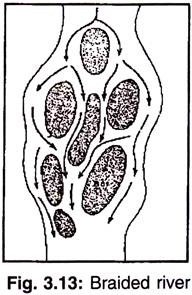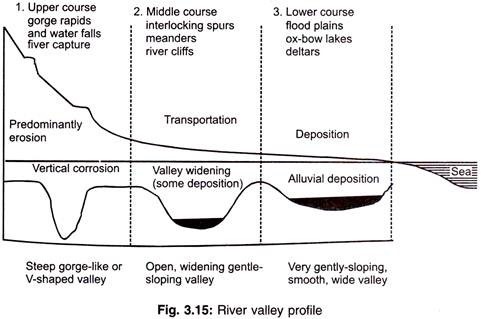ADVERTISEMENTS:
If we look into the whole length of a river we will notice that it has three definite courses: 1. The Upper or Mountain Course 2. The Middle or Plain Course 3. The Lower or Deltaic Course.
1. The Upper Course:
In the mountainous course, a river passes through a steep slope. Its water, therefore, rushes down with great speed. Under such a condition the water can dig the river bed very deeply and carries or pools down heavy boulders and pebbles. Erosion and transportation are the main activities of a river in the upper course.
A river has a deep and narrow channel in this stage. Moreover, some of the rocks over which a river flows are very hard, while the others are soft. As a result of this, the river course is not smooth. It has falls, cataracts and rapids in its course. The deep and steep-sided river valley is V-shaped here. Both erosion and transportation are active at this stage.
ADVERTISEMENTS:
Sometimes, the river flows through very hard rocks. In that situation the two sides of the river become so steep that they become almost vertical. The formation is known as Gorge. There are many gorges on the upper course of the Brahmaputra, the Indus, and the Ganges. Again when river flows through dry desert its bed becomes very deep and the two sides become vertical. The river valley takes the shape of I instead of V.
The Grand Canyon of the river Colorado of U.S.A. is one of the best examples. On the other hand, when river flows through soft rocks in the heavy rainfall areas erosion takes place towards the head of the river in addition to vertical and lateral erosion.
ADVERTISEMENTS:
As a result, the source of the river retreats. This type of erosion of the river is called Headword Erosion. The sources of Sutlej and Koshi have retreated towards Tibetan side and of Kaveri towards west in western ghats.
The other two important formations of the upper course of a river are—rapids and waterfalls. When water flows with high speed over the hard rock surface it is called rapids and when the water falls vertically downward it is called waterfalls.
ADVERTISEMENTS:
The Jog or Gerosoppa falls of Kaveri river, Dhuandhar falls near Jabalpur, Indrawati falls of Baster of Madhya Pradesh, Hundroo falls of Ranchi and Bidan and Bishop falls of Shillong are some of the famous waterfalls of India.
2. The Middle Course:
As a river leaves the hilly area and enters into a plain, its middle course starts. The slope of the river bed is less on a plain. Hence, the speed of the current is also less, compared to the upper course. The river is fed by many tributaries and its volume of water increases.
The water flows at a slow speed, it cannot very much erode the bed nor can it transport much material. But as the volume of water is more, the banks are eroded and the river becomes wide.
Towards the lower part of the plain course, the slope of the river bed becomes still less. The speed of the current also decreases. It can hardly erode and transport at this stage. The additional sediments carried by the river during the floods are deposited in this part. The channel is sometimes blocked, the river changes its course very often and becomes winding. Such a winding channel is known as a meander.
The lower part of the Dhansiri River of Assam has a highly meandering course. The water flowing through a meander normally strikes on its concave sides and erodes it. On the other hand, sediments are deposited on the convex sides.
Thus the gap at the mouth of a meander decreases. At the high flood time when water flows with speed the gap may be removed. The river finally finds a straight course leaving the meander aside. Such an abandoned meander is called as Ox-bow Lake.
There are many ox-bow lakes on the two sides of Beki and Dhansiri rivers of Assam. At the time of flood, water inundates the low-lying area by the side of the river. The silt carried by the flood is thus deposited in this area year after year and a plain is built up. Such a plain is known as flood plain. The main activities of a river at its middle course are some amount of erosion and some amount of deposition.
ADVERTISEMENTS:
At the foot of the mountains, the materials carried by the river from the upper course start collecting and take the shape of fan. It is called Alluvial Fan. In course of time many alluvial fans join together to make a plain. This type of plain at the foot of the mountain is called Bhabar.
3. The Lower Course:
The last part of a river near its mouth is called the lower course. In this part the slope of the river bed is not very steep. The current is also very slow. Deposition is the main activity of a river at this stage. The silt and other materials carried by the river are deposited. The river channel is blocked very often and new branch channels are dug out.
In this way branching takes place at the mouth of a river. These branch channels are known as distributaries and the river is said to be Braided. As the river meets the sea the current is almost halted.
The silt carried by the river water is, therefore, deposited at the mouth. In the course of time, the silt thus deposited forms a triangular island at the mouth of the river. This is known as delta. When the tidal waves and sea currents constantly wash the river mouth a delta cannot be formed. Such a free mouth of a river is called an estuary.
Majuli, the river island and Sundarban (1,25,00 sq km) the delta of the Brahmaputra and the Ganges are world famous. The deltas of the Nile, Mississippi, Volga, Po and Yangstze kiang are some of the world famous depositional features at the mouth of the river.









